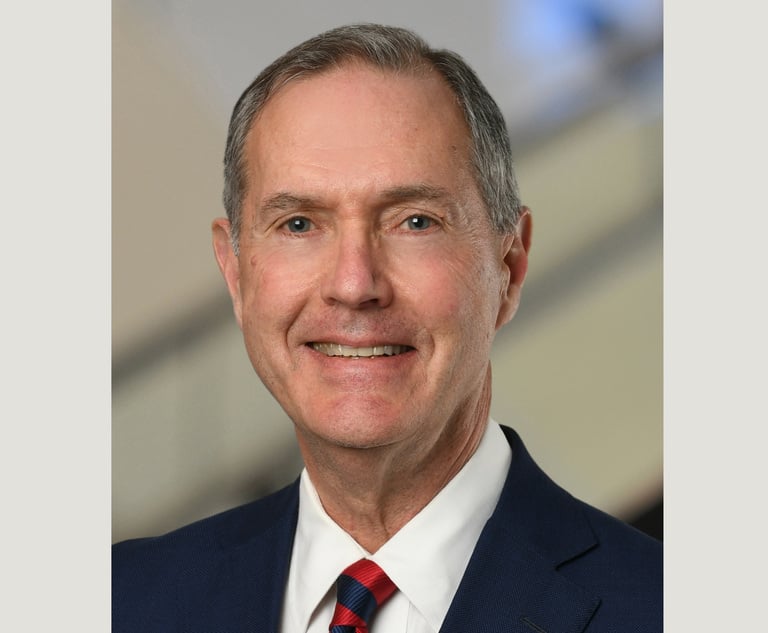How The Am Law 100 Left $4.4B On the Table in 2018
Discounted billable rates are costing law firms billions in lost profits. They aren't helping clients much, either. How can Big Law move beyond the discount?
April 23, 2019 at 09:50 AM
10 minute read
 Credit: Egle Plytnikaite.
Credit: Egle Plytnikaite.
Marci Eisenstein, the managing partner of Schiff Hardin, is among the few law firm leaders willing to be candid about an issue that affected as much as 45 percent of all Big Law revenue last year.
“There is no one in this business who doesn't provide discounts. No one,” Eisenstein says.
 Leverage the Am Law 100 data with firm comparison and key performance data, exclusively on Legal Compass. Access Premium Content
Leverage the Am Law 100 data with firm comparison and key performance data, exclusively on Legal Compass. Access Premium ContentLaw firms' standard rates are something akin to the prices at a discount jewelry shop, she adds.
“Have you ever seen something not on sale?” Eisenstein asks. “It makes you wonder what's going on.”
What is going on might be described as Big Law's discount culture. And it could be considered something of a slow-motion crisis, because it is far more complex, controversial and costly for the nation's biggest firms than what might be expected from a simple request: “Can you knock 10 percent off your rates?”
Sure, that question is nothing new for most Big Law partners. Discounts have been en vogue since the Great Recession, and there is no reason to think they are on the retreat. While discounted rates may feel like a necessary evil in order to win matters, an approach to work that ignores the price can be pernicious. Discounts have led to billions in lost potential profits, made a mockery out of what were once known as standard rates, and contributed to a new level of distrust among clients and law firms.
Start with the lost profits. Altman Weil last year asked firms what percent of their fees were generated under a discount, and the median response among firms with more than 250 lawyers was between 40 and 50 percent. In a separate survey, chief legal officers outlined a similar rebate frenzy. Roughly half received price cuts averaging between 6 and 10 percent.
If 45 percent of the Am Law 100's $98.8 billion in revenue last year was brought in at a 10 percent discount, the nation's largest law firms gave away about $4.4 billion in revenue. To make matters worse, that lost revenue cuts from firms' bottom lines, since law firm costs are fixed. Factoring in that lost income, profits per equity partner in the Am Law 100 would have been $2.1 million last year instead of $1.9 million. To think, some people consider couponing a hobby. It cost the average Am Law 100 partner more than $200,000 last year.
As for the standard rate itself, matters have become more confusing thanks to a chicken-or-egg dynamic: Are rates increasing to counteract discounts? Or are discounts a necessary response to an off-the-rails pricing strategy by law firms?
Data from Thomson Reuters Peer Monitor shows standard rates have risen by nearly 40 percent since 2007, which is nearly twice the rate of inflation during that period. But that doesn't mean much on its own, considering there has been a corresponding fall in the portion of that rate that actually gets paid. Realization rates have fallen from 92 percent in 2007 to a record-low 81 percent in 2018, Thomson Reuters reports.
The math works out like this: A $380 standard rate in 2007 turned into $350 in revenue that year, while a $525 standard rate in 2018 equated to $425 in revenue, according to Thomson Reuters data. That 21 percent rise in the actual cost-per-hour of legal work is almost perfectly in line with 11 years of inflation.
If clients and law firms have been finding a relatively reasonable price for Big Law services, the process to get to that point has become increasingly frustrating and burdensome, according to conversations with law firm leaders, pricing professionals, client-side purchasers and consultants.
There is a movement afoot within companies and firms alike to move beyond discounts. Most everyone agrees they largely fail to achieve even what clients are hoping for: price reductions or cost certainty.
“As I tell my clients who are proud of getting a 15 percent discount from their firms: 15 percent of infinity is still infinity,” says Ken Callander, a consultant to in-house legal departments who advocates value-based pricing structures. “Discounted rates don't stop firms from billing more hours.”
Discounts are a relatively new phenomenon in Big Law. In 2007, law firms received nearly 95 percent of the billing rate their clients agreed to pay, according to Thomson Reuters. That number has been below 90 percent since 2010. It actually rose 0.1 percent last year—the first increase since 2007. For GCs, discounts were seen as an easy way to assuage newfound C-suite level sensitivity to legal costs.
“It's a knee-jerk reaction now to ask for a discount,” says Eddie Raychaudhuri, a 10-year veteran of Big Law pricing roles who most recently served as chief pricing and legal project management officer at Berger Singerman. “It's kind of like the Groupon mentality: Everybody is asking for discounts on everything they can.”
Law firms have been struggling to react ever since the shift kicked in. A couple of years ago, a then-chairman of an Am Law 200 firm received a phone call from a friend who consults for legal departments. The consultant had a client, a Fortune 100 company's general counsel, who wanted to speak with the chairman about some potential matters.
So the chairman, who shared the story under the condition of anonymity to protect client relationships, took the call. The general counsel's first request: “I want to know how you can help me save 30 percent off my legal bills.” The chairman felt “sandbagged,” but nevertheless began discussing how his firm was working hard to lower its costs. The general counsel redirected the conversation: “No, I want to know how you can lower my costs by 30 percent.”
“I suppose I should have just said, 'What's the number and I'll do it for 30 percent less,'” the chairman says, half-joking.
To follow a conversation on this subject between The American Lawyer editor-in-chief Gina Passarella and executive editor Ben Seal beginning Tuesday, April 30, register here:
Conversations with clients that explicitly seek discounts on billable rates are not rare, according to law firm pricing professionals. One pricing officer of an Am Law 100 firm estimates that at least one-quarter of the firm's clients express a “need” for a discount.
Another pricing director at an Am Law 100 firm says a client mentioning a discount to a partner in a casual conversation is “the classic example” of how price sensitivity is communicated. Nowadays, the discount discussion has been formalized—and in a way that many pricing directors find stilted. “It has become a game,” one Am Law 200 pricing director says.
Some clients have written in 15 percent across-the-board rate discounts in outside counsel guidelines, pricing directors say. Clients ask for “early-pay discounts,” where a firm agrees to waive a percentage of a fee if it is timely paid. Often, discounts are baked into formal bids for work. Clients ask firms for detailed lists of their rates by practice group, attorney type and more. RFPs can simply be a fishing exercise meant to extract concessions from an incumbent firm.
“You read between the lines or you hear from a back channel that says, 'We have incumbents and we are just trying to keep them honest.' Or they might say, 'These incumbents are actually in danger of being unseated,'” one pricing director says.
Pricing directors are fond of the volume-based discount. If a client agrees to provide a firm with a certain amount and type of work, the firm will agree to a discount. Even though those deals are presumably reached through negotiation, they can nevertheless lead to resentment between a firm and a client.
One high-profile example of that occurred in 2016, when Quinn Emanuel Urquhart & Sullivan ceased participating in ride-share giant Uber's preferred outside counsel provider program, according to court documents unearthed in litigation.
In a letter to Uber's GC, Quinn Emanuel partner Stephen Swedlow wrote that the work the firm was given by Uber was at rates that were not “financially viable” for the firm unless it was also involved in high-value cases. Quinn Emanuel's decision was rare in that it became public, and because most firms would be reluctant to fire a company as large as Uber. But firms are increasingly rebuffing client demands for blanket discounts, according to law firm pricing professionals. Among legal departments with 51 or more lawyers, 65 percent of respondents to an Altman Weil survey said firms are pushing back.
Law firms are reluctant to discuss pricing strategies on the record, wary of creating conflict with clients. But among some pricing directors, there is pent-up frustration not only with clients that ask for discounts, but also other law firms that inflate their rates.
“If we, as an industry, condition our clients to expect a discount on rates, we're conditioning our clients to think of our rates as inflated,” says a chief strategic pricing officer who spoke under the condition of anonymity due to sensitivity inside his firm on the topic. Their firm has taken measures to combat discount culture, including requiring that a panel of partners reviews discount requests as low as 1 percent off the firm's standard rate.
Many firms have committees that green-light alternative fee arrangements and discounts. But they vary, and a 1 percent threshold is rare. Some firms, according to interviews with pricing directors, will allow partners to offer discounts as high as 15 percent without consulting the firm.
Timothy Corcoran, a consultant to law firms and legal departments, says clients asking for discounts on certain types of work represent a market signal that the standard rates no longer work. Law firms can respond by better managing costs and deciding what clients still want them to provide, he says.
“Discounting isn't necessarily bad for the firm, particularly if it is a reaction to the market's price pressure,” he says. “And in a price-sensitive market, if the client says, 'If you charge me less I will buy more,' then by discounting we might increase our profits.”
Still, most law firms are not expecting the billable hour to recede. They are bulking up their pricing professional ranks in an effort to shift conversations with clients beyond the discount and toward shared-risk model, asking pricing officers to broker agreements among partners and clients—a role they might not relish but may need to get used to.
“Part of my job is rate conservation,” one pricing officer says. “My theory is once you give out that discount, you're never getting it back.”
Email: [email protected]
This content has been archived. It is available through our partners, LexisNexis® and Bloomberg Law.
To view this content, please continue to their sites.
Not a Lexis Subscriber?
Subscribe Now
Not a Bloomberg Law Subscriber?
Subscribe Now
NOT FOR REPRINT
© 2025 ALM Global, LLC, All Rights Reserved. Request academic re-use from www.copyright.com. All other uses, submit a request to [email protected]. For more information visit Asset & Logo Licensing.
You Might Like
View All
Law Firms Look to Gen Z for AI Skills, as 'Data Becomes the Oil of Legal'

Law Firms Expand Scope of Immigration Expertise Amid Blitz of Trump Orders
6 minute read
Losses Mount at Morris Manning, but Departing Ex-Chair Stays Bullish About His Old Firm's Future
5 minute read
Trending Stories
- 1Uber Files RICO Suit Against Plaintiff-Side Firms Alleging Fraudulent Injury Claims
- 2The Law Firm Disrupted: Scrutinizing the Elephant More Than the Mouse
- 3Inherent Diminished Value Damages Unavailable to 3rd-Party Claimants, Court Says
- 4Pa. Defense Firm Sued by Client Over Ex-Eagles Player's $43.5M Med Mal Win
- 5Losses Mount at Morris Manning, but Departing Ex-Chair Stays Bullish About His Old Firm's Future
Who Got The Work
J. Brugh Lower of Gibbons has entered an appearance for industrial equipment supplier Devco Corporation in a pending trademark infringement lawsuit. The suit, accusing the defendant of selling knock-off Graco products, was filed Dec. 18 in New Jersey District Court by Rivkin Radler on behalf of Graco Inc. and Graco Minnesota. The case, assigned to U.S. District Judge Zahid N. Quraishi, is 3:24-cv-11294, Graco Inc. et al v. Devco Corporation.
Who Got The Work
Rebecca Maller-Stein and Kent A. Yalowitz of Arnold & Porter Kaye Scholer have entered their appearances for Hanaco Venture Capital and its executives, Lior Prosor and David Frankel, in a pending securities lawsuit. The action, filed on Dec. 24 in New York Southern District Court by Zell, Aron & Co. on behalf of Goldeneye Advisors, accuses the defendants of negligently and fraudulently managing the plaintiff's $1 million investment. The case, assigned to U.S. District Judge Vernon S. Broderick, is 1:24-cv-09918, Goldeneye Advisors, LLC v. Hanaco Venture Capital, Ltd. et al.
Who Got The Work
Attorneys from A&O Shearman has stepped in as defense counsel for Toronto-Dominion Bank and other defendants in a pending securities class action. The suit, filed Dec. 11 in New York Southern District Court by Bleichmar Fonti & Auld, accuses the defendants of concealing the bank's 'pervasive' deficiencies in regards to its compliance with the Bank Secrecy Act and the quality of its anti-money laundering controls. The case, assigned to U.S. District Judge Arun Subramanian, is 1:24-cv-09445, Gonzalez v. The Toronto-Dominion Bank et al.
Who Got The Work
Crown Castle International, a Pennsylvania company providing shared communications infrastructure, has turned to Luke D. Wolf of Gordon Rees Scully Mansukhani to fend off a pending breach-of-contract lawsuit. The court action, filed Nov. 25 in Michigan Eastern District Court by Hooper Hathaway PC on behalf of The Town Residences LLC, accuses Crown Castle of failing to transfer approximately $30,000 in utility payments from T-Mobile in breach of a roof-top lease and assignment agreement. The case, assigned to U.S. District Judge Susan K. Declercq, is 2:24-cv-13131, The Town Residences LLC v. T-Mobile US, Inc. et al.
Who Got The Work
Wilfred P. Coronato and Daniel M. Schwartz of McCarter & English have stepped in as defense counsel to Electrolux Home Products Inc. in a pending product liability lawsuit. The court action, filed Nov. 26 in New York Eastern District Court by Poulos Lopiccolo PC and Nagel Rice LLP on behalf of David Stern, alleges that the defendant's refrigerators’ drawers and shelving repeatedly break and fall apart within months after purchase. The case, assigned to U.S. District Judge Joan M. Azrack, is 2:24-cv-08204, Stern v. Electrolux Home Products, Inc.
Featured Firms
Law Offices of Gary Martin Hays & Associates, P.C.
(470) 294-1674
Law Offices of Mark E. Salomone
(857) 444-6468
Smith & Hassler
(713) 739-1250










